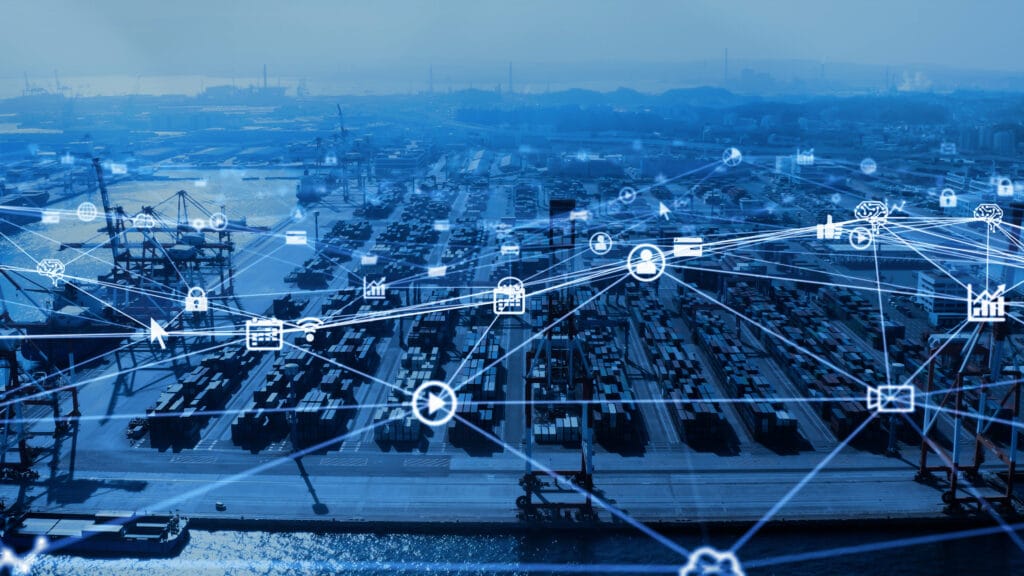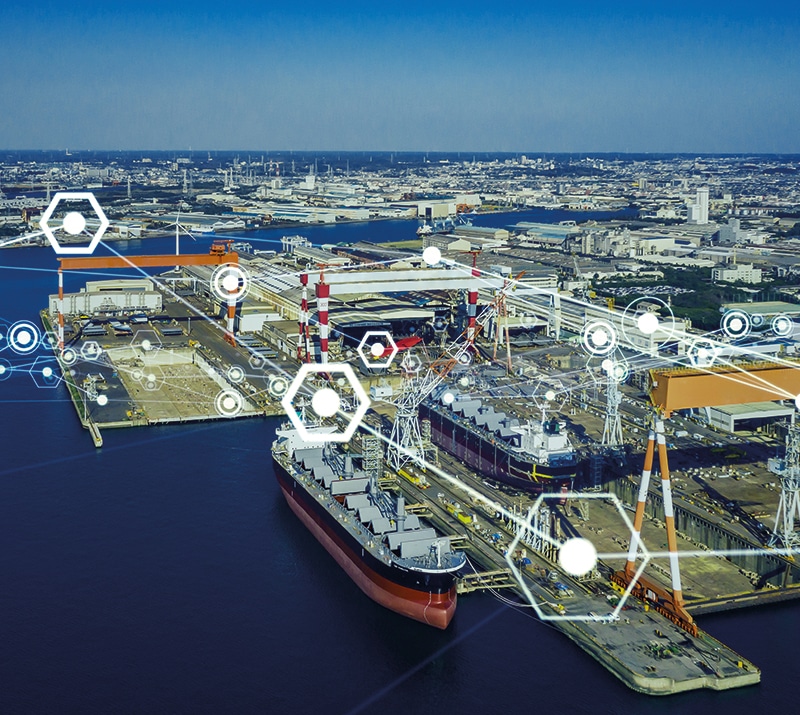For the maritime industry, digitalization has become mandatory to tackle the challenges of the 21st century. Building fully autonomous vessels is one of the goals set, and several countries work on such projects. Until then, existing ships use an increasing range of technologies to work smarter. Alike other economic sectors, the maritime industry has to adopt digital technologies to remain competitive. It’s important also to reduce the negative impact of human actions and shipping on the ocean. The new technologies used by ships will help to do this and diversify marine industry.
What technologies make cargo ships smarter?
In order to move towards a higher level of autonomy, the entire maritime industry relies on Artificial intelligence, automation, data analytics, the Internet of Things (IoT). Modern vessels are equipped with several kinds of sensors, devices, and advanced technologies. We can call these vessels: smart vessels.
- Integrated control system
Monitoring the various systems and keeping an eye on every corner of a cargo ship is impossible considering its dimensions, the number of docks, personnel, containers, and other cargo. An integrated control system includes sensors, cameras, and other units connected to a central server. Having a consolidated overview of all parts of the vessel on a unique interface at any time, the captain or the officers in charge can better manage this huge entity. Any anomaly (temperature, engine rpm) activates an alert to the concerned unit, which is transmitted to the bridge.
- Speed log
It measures the ship’s velocity in water, which is one of the indicators used for performance calculation. Multiple factors may affect these measurements: water clarity, the state of the sea that may slow down the vessel, and aeration.
How Is ETA Computed Using Artificial Intelligence ?
The ETA computations explained are to help ports and the shipping industry understand how ETA is computed and how important a precise ETA is for their business activities. ETA is one of the most influential factors for maritime supply chain efficiency…
- Wind anemometer
Generally installed in the bow of the mast, this device measures the relative wind speed and direction. The figures collected are then converted into real wind speed and direction in the onboard system (ECDIS).
- Geolocation
Geolocation technology allows the real-time location of any ship in the fleet, wherever it is. Its features help in route selection, ETA calculation, and additional support in case needed.
It provides information about the speed of the vessel measured over the ground whereas the speed log measures water speed.
- Echosounder
It eases navigation in confined waters. With a frequency set to 50 kHz, it can detect the seabed at a depth of about 90–150 m. The level of detection and measurements accuracy, however, depends on the state of the sea, the salinity and temperature of the seawater, and the noise created by the engine and the propeller.
- Rudder indicator
The rudder direction may frequently shift during sailing because of the propeller rotation, the wind action on the structure, and the ship’s hull. This device, therefore, measures the rudder angle continuously.
- Robotics
Several companies are already using robots instead of humans to perform tasks in risky environments: maintenance, on-site inspections, hull cleaning and/or painting. It is the best solution, especially during times of restrictions.
Experimentation with drones is also ongoing, for example for goods delivery on board, surveillance, or remote inspections, as well as 3D Printing, so as to fasten spare parts availability. And as technology evolves further, advanced robotic technologies will be extensively used to resolve many issues.
- Augmented Reality
The use of augmented reality (AR) has multiple purposes for the maritime industry: enhance training efficiency for seafarers through real-life experiences, conduct repairs and maintenance without having a technician on-site thanks to remote guidance software linked to AR wearables.
Why are the new technologies essential for cargo ships?

New technologies used onboard cargo ships enable the industry as its whole to reach higher levels of innovation and help all stakeholders in various aspects. The future of the marine industry will turn around by reducing energy consumption and make companies and ships more efficient by using new technologies.
- Smooth communication
Thanks to the Internet and modern communication tools, the vessel/s crew is in continuous contact with the shore-based teams and exchanges real-time and reliable information. This close collaboration is key to make the best decisions whenever required and plan efficient operations.
The data obtained from a ship’s AIS (Automatic Identification System) are also useful for other purposes. For example, Sinay has developed software that uses these data, along with historic voyage data and metocean data, to calculate the ship’s arrival time at the next port of call with a high level of accuracy.
- Safety
With the help of sensors, combined with AI and machine learning-based devices installed onboard, navigation and maneuvers are easier for the helmsman. These modern features enable the ships to stay on course, berth without colliding, and more generally, lessen accidents due to human errors.
- Cost-efficiency
In a heavily competitive market, shipping lines have to deal with tight margins. The Covid-19 pandemic and its economic consequences have raised major new challenges: port congestion, lack of empty containers, oil prices surge… In order to cut costs, they have to find ways to lower fuel consumption, since one single vessel can burn up to 30 tons daily.
The analysis of inputs transmitted from the vessel, and third-party sources about the weather conditions, the state of the sea, etc., helps the captain choose the optimal route and speed of the ship.
Besides, the risk of damage to equipment and the ship itself gets down. This means lower expenditures for the repair and maintenance at a time when the price and availability of spare parts are great concerns.
- Operational efficiency
Automated cranes and equipment are used for cargo loading/offloading and other handling operations on the ground or onboard the vessel. This reduces manual intervention, which speeds up the process and allows for significant time-saving. It contributes to maintaining the vessel’s schedule and offers a solution to congestion that affects many ports worldwide, especially in China, the US, and Europe…
The information received is also exploited by the shipping line to evaluate each vessel’s performance.
- Carbon impact reduction
All initiatives driven by the maritime transportation industry contribute to cutting greenhouse gases emissions and protecting the environment in general and the marine ecosystem in particular. Still, the sector is one of the most polluting and has great efforts to do to reduce its carbon footprint ,fight against climate change and save the ocean.
How Is ETA Computed Using Artificial Intelligence ?
The ETA computations explained are to help ports and the shipping industry understand how ETA is computed and how important a precise ETA is for their business activities. ETA is one of the most influential factors for maritime supply chain efficiency…
Conclusion about technologies that ships have
Significant progress has been made in these past years for the digitalization of the maritime industry. New technologies are spreading quickly among all market players around the world. Investments in R&D have to continue as it is important to get innovative solutions emerging.
Yet much remains to do. Training people and raising awareness require important efforts. Laws and regulations have to adapt to the ongoing and upcoming changes. The IMO has taken the lead on it but. Last, many countries are late in this regard, and this may slow the process and several questions remain unanswered: how could a 100% autonomous ship communicate and plan operations if some ports are not automated themselves?
Frequently Asked Questions About technologies that ships have
- Integrated control system
- Speed Log
- Wind anemometer
- Geolocation
- GPS
- Echosounder
- Rudder indicator
- Robotics
- Augmented Reality
Yes, there is noise pollution in the ocean which severely threatens marine life such as whales and dolphins. Just as humans are sensitive to noise, so are underwater mammals. Plus, mammals like cetaceans use sound as we use our eyes; therefore, underwater noise pollution is “blinding” for species likes whales.
Smart vessels are part of smart shipping. We speak about smart shipping when the industry/vessel used some digital tools for fleet management, navigation, port operations, and much more.





